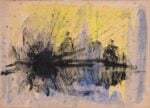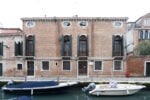Tobias Zielony – Overshoot

Mostra personale di Tobias Zielony dal titolo Overshoot, che segna il ritorno dell’artista in città.
Comunicato stampa
La Galleria Lia Rumma di Napoli inaugura, giovedì 14 novembre 2024, la mostra personale di Tobias Zielony dal titolo Overshoot, che segna il ritorno dell’artista in città.
Il titolo della mostra si riferisce all’ultima serie fotografica realizzata quest’anno a Napoli dall’artista tedesco e commissionata dal Museo Madre per il recente progetto espositivo “Il resto di niente”, a cura di Eva Fabbris con Giovanna Manzotti.
Lo sguardo particolare di Tobias Zielony, che ha già lavorato a Napoli sulle Vele di Scampia nel 2010, questa volta punta l’obiettivo sui luoghi più significativi progettati e immaginati da Aldo Loris Rossi (1933-2018), l’architetto e teorico napoletano, un radicale in tutti i sensi, che spesso ha lavorato in collaborazione con l’architetto Donatella Mazzoleni. «Il termine “Overshoot” - racconta Zielony - rimanda al nome della trasmissione radiofonica su Radio Radicale alla quale Aldo Loris Rossi partecipò regolarmente. Letteralmente significa “andare oltre l'obiettivo, esagerare, spendere troppo, ecc.”. Negli ultimi anni questo termine è stato usato per descrivere lo sfruttamento di più risorse di quelle che la terra può sostenere da parte dell’uomo. Questa idea di eccesso, di andare volontariamente oltre ciò che è ragionevole e razionale, potrebbe essere usata per descrivere la visione architettonica di Rossi e Mazzoleni. L'abbondanza di forme, il complesso simbolismo e l'amore per le idee e le forme futuristiche li hanno portati a progettare e costruire una serie di edifici davvero unici e fantasmatici».
La mostra presenta una ricca selezione di immagini e un’animazione in stop-motion del progetto “Overshoot”. Tobias Zielony ci mette di fronte ad alcuni degli utopici edifici architettonici di Aldo Loris Rossi: il complesso residenziale di Piazza Grande ai Ponti Rossi, la Casa del Portuale nella zona di via Marina e la Chiesa di Santa Maria della Libera e del Santissimo Redentore di Portici, che, come le altre progettazioni dell'urbanista di Bisaccia (scomparso nel 2018) traevano ispirazione per la parte disegnata dal futurista Antonio Sant'Elia e per quella progettuale dall'architettura organica di Frank Lloyd Wright. Progetti visionari ri-guardati oggi dal grande fotografo tedesco nel loro attuale contesto sociale e urbanistico. La visione di Zielony segue le strutture degli edifici e i movimenti delle persone che li abitano, dando vita a un flusso apparentemente infinito di immagini e prospettive possibili. Non c’è un solo modo di guardare le realtà architettoniche e sociali che si rimodellano continuamente nel tempo.
Le foto di Zielony partono tutte da un’indagine compiuta tra i sobborghi delle città e presentano interessanti combinazioni tra architettura e ritratto. Habitat che non sono più animati da un’utopia urbana e sono diventati una tipologia di “città autonoma nella città”. «Non voglio fare reportage sociali» afferma l’artista che utilizza un approccio narrativo e visivo tipico del cinema, che aumenta il divario tra reale e irreale, tra ciò che accade dietro e davanti l’obbiettivo. C’è sempre una forma di ambigua e disarmante bellezza nel disagio sociale catturato dall’artista. Lo sguardo soggettivo e privo di ogni patetismo di Zielony insegna a prendere il mondo così com’è, permettendo a chiunque di avere una voce. Le sue foto rivelano ma non spiegano.
Un ringraziamento speciale a Sabato De Sarno e Gucci
Tobias Zielony (1973, Wuppertal, Germania), studia fotografia alla University of Wales di Newport e all’Accademia di Belle Arti di Leipzig. È riconosciuto a livello internazionale per i suoi progetti a lungo termine con adolescenti e giovani adulti ritratti in particolari contesti architettonici e sociali. Zielony opera a livello globale ed esplora l'intersezione tra affermazioni finzionali e documentarie e indaga il potenziale politico ed estetico, nonché i confini dell'autentica auto-rappresentazione. Nel 2010 ha realizzato con la Galleria Lia Rumma il progetto “Vele”, dedicato all'omonimo complesso residenziale concepito negli anni '60-'70 dall'architetto Franz Di Salvo nel quartiere di Scampia, alla periferia nord di Napoli. Il progetto è stato presentato nel 2012 in due grandi mostre, al MAXXI di Roma e al Philadelphia Museum of Art. Tra le principali mostre personali ricordiamo inoltre: “Dark Data”, Marta Herford (2022); “The Fall”, Folkwang Museum Essen (2021); “Jenny Jenny”, Berlinische Galerie (2013); “Tobias Zieony”, MMK Zollamt Frankfurt (2011); “Manitoba”, Camera Austria Graz (2011); “Story/No Story”, Kunstverein Hamburg (2010). Nel 2015, con il lavoro “The Citizen” è tra gli artisti invitati a esporre nel Padiglione Tedesco, curato da Florian Ebner, alla 56a Biennale di Venezia. Ha vinto il premio GASAG nel 2006 e il Karl-Ströher-Preis nel 2011; ha partecipato all’International Studio Program, New York (2006). Tra le pubblicazioni più recenti: “Wolfen” (2023), “The Fall” (2021), “Vele” (2014), “Jenny Jenny” (2013), “Manitoba” (2010), Spector Books; “Maskirovka”, Mousse Magazine (2017); “Story / No Story”, Hatje Cantz (2010). Dal 2022 è professore di fotografia presso la HFBK di Amburgo.
The Lia Rumma Gallery in Naples is pleased to announce the opening, on Thursday 14 November 2024, of the solo exhibition by Tobias Zielony entitled Overshoot, which marks the return of the artist to the city.
The title of the exhibition refers to the latest series of photographs taken this year in Naples by the German artist and commissioned by the Museo Madre for the recent exhibition “Il resto di niente”, curated by Eva Fabbris with Giovanna Manzotti.
The distinctive gaze of Tobias Zielony, who already worked in Naples on the Vele housing complex in Scampia in 2010, focuses this time on the most significant places designed and imagined by Aldo Loris Rossi (1933-2018), the Neapolitan architect and theoretician - a radical in every sense - who often worked in close collaboration with the architect Donatella Mazzoleni. “The term ‘Overshoot’,” explains Zielony, “refers to the name of the radio programme broadcast on Radio Radicale on which Aldo Loris Rossi frequently appeared. It literally means ‘going past a set point, exaggerating, spending too much, etc.’. In the last few years, the term has been used to describe the exploitation by humankind of more resources than the Earth can sustain. This notion of excess, of going intentionally beyond what is reasonable and rational, could be used to describe the architectural vision of Rossi and Mazzoleni. The abundance of forms, the complex symbolism and love of futuristic ideas and forms led them to design and construct a series of truly unique and phantasmal buildings”.
The exhibition presents a rich selection of images and stop-motion animation from the “Overshoot” project. Tobias Zielony brings us face to face with some of Aldo Loris Rossi’s utopian works of architecture: the residential complex of Piazza Grande at Ponti Rossi, the Casa del Portuale in the area of via Marina and the church of Santa Maria della Libera e del Santissimo Redentore in Portici which, like other designs by the town planner (who died in 2018) were inspired, in terms of draughtsmanship, by the futurist Antonio Sant'Elia and, in terms of design, by the organic architecture of Frank Lloyd Wright. These visionary designs have been re-examined by Zielony in their current social and urban context. Zielony’s vision follows the structures of the buildings and the movements of the people who inhabit them, giving rise to a seemingly infinite flow of possible images and perspectives. There is not just one way to look at architectural and social realities that continuously remodel themselves over time.
Zielony’s photographs all start from an investigation carried out in city suburbs and provide interesting combinations of architecture and portraiture. These habitats are no longer animated by an urban utopia and have become a type of ‘autonomous city within the city’. “I don’t want to create social reportage”, states the artist, who uses a narrative and visual approach typical of cinema, increasing the divide between reality and unreality, between what happens behind and in front of the camera lens. There is always a form of ambiguous and disarming beauty in the social hardship captured by the artist. Zielony’s subjective gaze, entirely lacking in sentimentality, teaches us to accept the world as it is, enabling everyone to have a voice. His photographs reveal but do not explain.
Special thanks to Sabato De Sarno and Gucci
Tobias Zielony (1974, Wuppertal), studied Photography at the University of Wales in Newport and at the Academy of Fine Arts in Leipzig. He became internationally known for his long-term projects with adolescents and young adults, portraited in particular architectural and social contexts. Zielony works globally and explores the intersection of fictional and documentary statements and investigates the political and aesthetic potential as well as the boundaries of authentic self-representation. In 2010 he produced the Vele project in collaboration with Galleria Lia Rumma, presented in two major solo exhibitions at the MAXXI in Rome, and at the Philadelphia Museum of Art in 2012. Other solo exhibitions include: “Dark Data”, Marta Herford (2022); “The Fall”, Folkwang Museum Essen (2021); “Jenny Jenny”, Berlinische Galerie (2013); “Tobias Zieony”, MMK Zollamt Frankfurt (2011); “Manitoba”, Camera Austria Graz (2011); “Story/No Story”, Kunstverein Hamburg (2010). In 2015, with the work "The Citizen" was among the artists invited to exhibit in the German Pavilion, curated by Florian Ebner during the 56th Venice Biennale. He won the GASAG prize in 2006 and the Karl-Ströher-Preis in 2011; he took part in the International Studio Program, New York. Among the most recent publications: Wolfen (2023), The Fall (2021), Vele (2014), Jenny Jenny (2013), Manitoba (2010) Spector Books; Maskirovka, Mousse Magazine, 2017; Story / No Story, Hatje Cantz, 2010. Since 2022 he is professor at HFBK in Hamburg.



